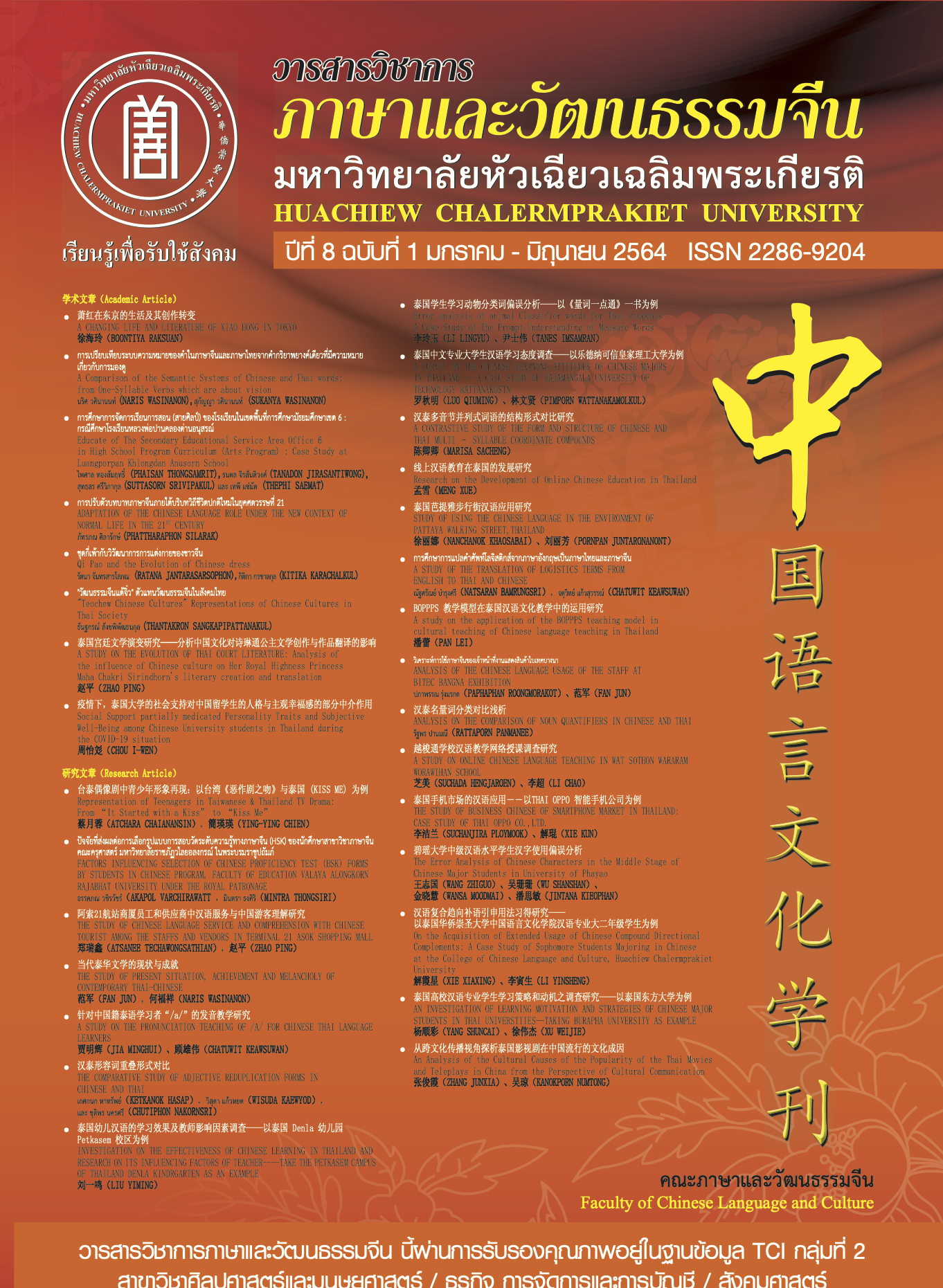A Comparison of the Semantic Systems of Chinese and Thai words: from One-Syllable Verbs which are about vision
Abstract
This article compares the semantic systems of Chinese and Thai words by studying from the meaning of one-syllable verbs which are about vision. The objective of this study was to study the difference and generalization of the semantic system of Chinese and Thai words. The verbs studied refer to the meaning from the Contemporary Chinese Dictionary (Sixth revision), the Royal Institute's Dictionary (2011) and Chinese-Thai Dictionary (2016), comparing 3 aspects of the verbs: 1. The semantic group of verbs 2. The list of meanings of verbs 3. The ability to form verbs.
The results of a comparative study can be seen that different languages have a semantic system that expresses both the same and different meanings. Both Chinese and Thai languages have identity systems of meanings. Chinese has more verbs which are about vision than Thai. This result from a logic or a detailed idea of how to form words. Along with the Chinese language has a long history and evolution. Therefore, Word formation is more numerous. For this reason, from the study of the semantic system of Chinese and Thai language, whether it is the dimension of the words group, or the ability to form words and the number of lists of meanings of the verb groups all reflect different semantic systems. The same aspect is the one-syllable verbs which are about vision in Chinese and Thai can find most hostesses or comparisons. And this phenomenon is considered a linguistic phenomenon of all languages.
Keywords: Chinese and Thai Comparison, Semantic System, one-syllable verbs which are about vision
References
นววรรณ พันธุเมธา. (2557) คลังคำ. กรุงเทพมหานคร : อัมรินทร์.
เธียรชัย เอี่ยมวรเมธ. (2559) พจนานุกรมจีน-ไทย ฉบับใหม่. พิมพ์ครั้งที่ 33. กรุงเทพมหานคร : รวมสาส์น.
ราชบัณฑิตยสถาน (2556) พจนานุกรมฉบับราชบัณฑิตยสถาน พ.ศ. 2554. กรุงเทพมหานคร : นานมีบุ๊คส์
พับลิเคชั่นส์.
杨汉川(1991),泰语词典(崇圣册).曼谷:Wattanaphanit 出版社.
杨汉川(1996),汉泰语双解词典 曼谷:Ruamsarn 出版社.
符淮青1983 现代汉语词汇.北京:北京大学出版社.
符淮青1996 词汇分析和描写 北京:语文出版社.
朱星1981汉语词义简析 北京:北京大学出版社.
徐国庆1999 现代汉语词汇系统论 北京:北京大学出版社.
高更生、谭德姿和王立廷 1995 现代汉语知识大辞典 济南:山东教育出版社.
符淮青1994 看和看见等词义同异和制约载于学汉语第五期1-5页.
符淮青1981 义项的性质和分合.上海:辞书研究 第4期86-94页.
符淮青1996 汉语词汇发展史. 合肥:安徽教育出版社.
常敬宇1996 论词的表层义和深层义-----兼论词义系统 词汇学新研究.
贾颜德 1999 汉语词义学 北京:北京大学出版社.
王宁和皱晓丽 1999 词汇应用通则. 辽宁:春风艺术出版社.
董大年1998 现代汉语分类词典 北京:汉语大辞典出版社.
潘允中1989 汉语词汇史概要 上海:上海古籍出版社.
赵克勤1994古代汉语词汇学 北京:商务印书馆.
中国社会科学语言研究所词典编辑室 (1978)现代汉语词典 北京:商务印书馆.
周荐 1995 汉语词汇研究史纲 北京:语文出版社.
伍谦光 1987 语义学导论 上海:上海古籍出版社.
Downloads
Published
How to Cite
Issue
Section
License
บทความที่ได้รับการตีพิมพ์เป็นลิขสิทธิ์ของวารสารภาษาและวัฒนธรรมจีน มหาวิทยาลัยหัวเฉียวเฉลิมพระเกียรติ
บทความใน “วารสารวิชาการภาษาและวัฒนธรรมจีน” เป็นทรรศนะของผู้เขียนโดยเฉพาะ กองบรรณาธิการไม่มีส่วนในความคิดเห็นในข้อเขียนเหล่านั้น




